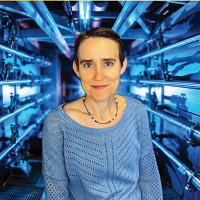Using High Energy Density Plasmas for Nuclear Experiments Relevant to Nuclear Astrophysics
Using High Energy Density Plasmas for Nuclear Experiments Relevant to Nuclear Astrophysics
The seminar will be conducted in person and simulcast via Zoom.
Passcode: MIPSE
In this seminar, Dr. Gatu Johnson will describe how HED laser facilities such as NIF and OMEGA can generate plasma conditions that simulate astrophysical phenomena – such as the fundamental energy producing nuclear reactions that occur inside stars.
Date and Time
Location
Hosts
Registration
-
 Add Event to Calendar
Add Event to Calendar
Speakers
 Dr. Maria Gatu Johnson of MIT Plasma Science and Fusion Center
Dr. Maria Gatu Johnson of MIT Plasma Science and Fusion Center
Using High Energy Density Plasmas for Nuclear Experiments Relevant to Nuclear Astrophysics
Thermonuclear reaction rates and nuclear processes have
traditionally been explored by means of accelerator experiments, which are difficult to execute at conditions relevant
to stellar or big bang nucleosynthesis. High energy density
(HED) plasmas generated using lasers, such as the inertial
confinement fusion (ICF) platforms at the NIF and OMEGA facilities, more closely mimic astrophysical environments in
several ways. These include thermal distributions of reacting
ions as opposed to mono-energetic ions impinging on a cold
target; stellar-relevant plasma temperatures and densities;
and neutron flux densities not found elsewhere on earth.
This talk will present some initial nuclear astrophysics-relevant results for the T+T and solar 3
He+3
He reactions using this
platform to illustrate the possibilities, and describe efforts to
study the 3
He+3
He reaction at stellar-relevant conditions at
NIF and with unprecedented data quality at OMEGA. Future
directions, including platform developments to study CNOcycle-relevant reactions including higher Z ions, neutron capture on nuclei in excited states and electron screening will
also be discussed. The work was supported in part by the US
DOE, LLE, and LLNL.
Biography:
Dr. Maria Gatu Johnson is a principal research scientist at the MIT Plasma
Science and Fusion Center, where she develops and uses nuclear diagnostics to diagnose inertial
confinement fusion (ICF) experiments. In particular, she has focused her efforts on working to
understand stagnation physics in ICF implosions, helping guide the ICF program at the National
Ignition Facility (NIF) to ignition and energy gain and the program at the OMEGA laser facility to
record yields. Another primary focus of her work is plasma nuclear science-relevant basic-science
experiments at OMEGA and the NIF. She also manages an accelerator laboratory at MIT dedicated
to diagnostic development for ICF and high energy density physics (HEDP) experiments. She obtained her PhD from Uppsala University, Sweden, in 2010, working on neutron diagnostics for the
JET tokamak. She is the recipient of awards including the 2019 Katherine E Weimer Award, and is
a Fellow of the American Physical Society. She is proud to be an APS DPP Ally since 2019.
An IEEE Southeastern Michigan Section event. All are welcome. Consider becoming an IEEE member if such similar events are of professional/academic interest to you

